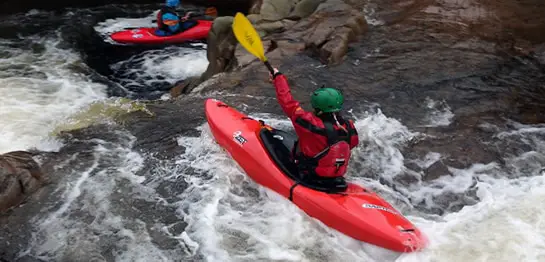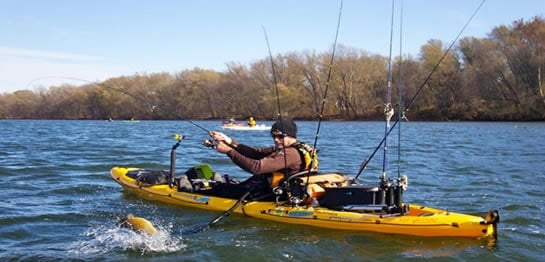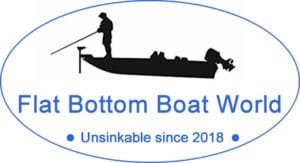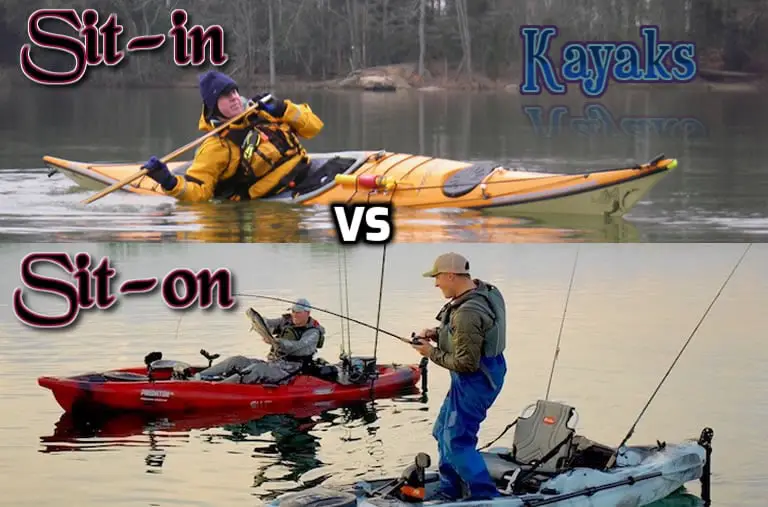Contents
Sit In vs Sit On Kayak
What is the difference between a sit on vs sit in kayak?
A sit in kayak is ideal for cruising, touring, camping, whitewater sports, ocean use and beginners. It has limited storage and a closed cockpit with no deck space or onboard maneuverability. A sit on kayak is a great recreational boat that offers open deck space, more storage and the ability to move more freely onboard but is more limited in its uses.
Sit In vs Sit On Kayaks – The Differences
The obvious difference between the two types of kayak are how you sit in them.
A sit in kayak has a cockpit that covers the lower part of your body and with the aid of a fabric deck keeps the lower part of your body protected from water.
On a sit on top kayak your entire body is open to the elements, as is your gear and anything else you have stored on the boat. However, this is not the only difference.
A sit in kayak is much more difficult to get in and out of but it gives you a lower center of gravity when you are in it which makes the boat a lot more stable in the water.
This also keeps you drier from the water that drips off the paddles because you are close to the water surface.
A sit on top kayak is wider and has great primary stability but has less secondary stability. It can feel more tippy in choppy water. For more about primary and secondary stability read this.
On a sit on top kayak you will also get wet, not just from rain or splashing waves but also from water dripping off the paddles.
A sit in kayak is easy to roll. If the boat capsizes you can easily right it topside. Your gear also remains protected in the sealed compartments.
If a sit on top kayak capsizes it is more difficult to right it and your gear will float away and get wet if it is not protected in waterproof bags.
A sit in kayak is much easier to maneuver than a sit on top model. This is especially true if you are paddling over distances.
A sit on top will tend to move in the direction of each paddle stoke, while a sit in kayak will stay in a straight line.
Sit in kayak best uses
Here is a list of the most common uses for a sit in kayak:
- Ocean use
- Camping
- Long journeys
- Whitewater river kayaking
- Surf kayaking
- Recreational cruising in all types of environments
Be aware that there is no one-boat-fits-all option available when it comes to a sit in kayak.
For example, a flat bottom recreational kayak is a very bad choice for whitewater use.

If you intend to boat in weather and water than are in any way challenging or you like to paddle over distances then a site-in kayak is the best choice over a sit on top one.
Sit in kayak pros
- Lighter
- You stay warmer
- You stay drier
- More versatile for different environments
- There is at least one sit in kayak that is perfect for your intended environment
- Great travelers – long journeys, camping etc.
- Gear is kept dry in sealed compartments
- Sleeker with lower center of gravity for great secondary stability
- Faster
- Easy to maneuver and keep straight while paddling
- Very easy to “right” if capsized (you can easily roll a kayak)
- Gear will stay dry in waterproof compartment if kayak is rolled
Sit in kayak cons
- Harder to get in and out of
- Difficult or impossible to access gear while in the boat
- Limited storage
Sit on top kayak best uses
Here is a list of the most common uses for a sit on top kayak:
- Fishing
- Hunting
- Recreational use in calm waters and fair weather
- Group activities (multiple people on one boat)
- Boating with dogs (more on that here)
If you are a fair-weather-boater and love to take a boat out on calm water in good weather then a sit on top kayak would be a great choice for you.

These boats are super fun and very comfortable and convenient to use.
Sit on top kayak pros
- Easier to get in and out of
- Wider for better primary stability – enough stability to stand in them
- More storage
- More deck space
- Better for fishing and hunting
- Easy access to onboard stored gear
- More customizable
- Better for fishing, hunting etc.
- Available as hybrid canoe-kayaks
- Great recreational vessel in calm water and good weather
Sit on top kayak cons
- Heavier
- Not good for long journeys
- Access to certain environments is limited (such as turbulent open water and whitewater)
- Good only in calm water
- You are more likely to get wet
- Slower
- You need to wrap gear in waterproof bags
- More difficult to keep straight when paddling
- More difficult to right if capsized
- Gear will get wet or could be lost if kayak capsizes
If you are unsure which type of kayak is best for you then you should start with a few simple questions.
Answering these questions will help you identify whether a sit in or sit on kayak will suit your needs better.
Sit in vs sit on kayak – how to know which is best for you
Before I cover the differences between a sit in and a sit on (more commonly known as a sit on top) kayak it is important for me to help you get clarity about what you want this type of boat for.
Once you are clear on exactly how you intend to use the boat it will be fairly easy for you to make a decision about which vessel is better for you as each one has different strengths and weakness.
Ask yourself the following questions
- What will you use the boat for?
- Where will you use the boat?
- How many people and how much gear will be onboard?
With the answers to the above questions you will be armed with all the knowledge you need to make the correct buying decision.
Identify the main purpose of the kayak
Although a sit in and a sit on kayak are essentially the same type of boat they have such key design differences that you should consider them to be completely different types of vessels.
By identify the main purposes for your boat it will become easier for you to see which type of kayak is better for your purposes and which type would not be a good fit.
For example, a sit on top fishing kayak is great for fresh lake use but would be a terrible choice for ocean cruising; a sit in touring kayak would offer much more protection, safety and maneuverability in turbulent waters.
So how do you intend to use your boat? Below are a few of the more common kayaking activities to get you thinking:
- Fishing
- Hunting
- Whitewater sports
- Surf kayaking
- Recreational cruising
- Long journeys on inland waterways
- Ocean touring
- Camping
Sit in kayaks are the best choice for some of the above activities while sit on top kayaks are better equipped for others.
So first identify what you intend to use your kayak for.
Then when you review the pros and cons of each boat type below you will instantly be able to tell which design is better for your intended purposes.
For long journeys, camping and ocean use, for example, a sit in kayak offers you a lot more comfort, ease of paddling and protection from the elements – not to mention speed.
However, if you love to fish in calm waters and fair weather then a sit on top kayak offers room for gear, and easy access to it, rod holders and the ability to move about on the boat and stand up on it.
Knowing where you will you use the boat will help you identify which kayak is best for you
So where do you intend to use your new boat? Although the environment in which you will use your kayak is strongly linked with how you will use it, this is still a question that deserves to be asked.
The difference in designs between a sit in and a sit on top kayak mean that each boat type is better suited to, not just certain activities but also to, certain environments.
One of the most obvious differences between the two boats is that sit on top kayak leaves you much more open to the elements while a sit in kayak protects you, to a large extent, from the elements.
If you plan to use your kayak in calm water and in fair weather then a sit on top kayak offers a lot of advantages over a sit in kayak (for certain activities).
However, in challenging waters and bad weather you will always be better off in a sit in kayak. Likewise, for whitewater sports a sit in kayak is the best choice as these boats are easy to roll, keep you drier and a river/whitewater kayak has exceptionally good secondary stability to ride rough turbulent rapids.
Know how much storage capacity you will need
If you you plan to go on a family outing or fishing with buddies then you need more deck space and more seats.
Although there are tandem (and 3-person) sit in kayaks, a sit on top kayak will always offer more room for more passengers and more gear.
You should also note that although there are large 16+ feet sea kayaks that can store a lot of gear for the most part a sit on top kayak will give you more space.
In addition, the gear you bring with will be within easy reach on a sit on top kayak whereas it will be in sealed compartments on a sit in kayak that are only accessible when you get out of the boat.
The downside to this extra storage room on a sit on top kayak is that you will have to ensure your gear is put in waterproof bags or you run the risk of it getting wet.
Making the final decision
Below are a few tables to help you see instantly which kayak type is best suited to specific applications and environments.
Be sure to also watch the video below that covers the main areas where sit in kayaks differ from sit on kayaks and how those differences affect performance and usability.
Comparison Tables – Sit In vs Sit On Kayak
When reviewing the tables below please bear in mind that different types of sit in kayaks have different and distinct advantages.
The pros associated with sit in kayaks in the tables below are pros for different types of kayak and not for a sit in kayak in general (because there are different kayak types designed for different purposes).
For example, one of the tables below indicates that a kayak is suitable for use in the ocean, but this does not mean that any kayak can be used safely in the ocean; it means that there is a kayak available that has been specifically designed for ocean use.
A leisure kayak is not suited to ocean use for example; you will need a sea or touring kayak for ocean kayaking.
Ideal Kayaking Environments
| Calm water | Shallow water | Ocean use | Rough Water | |
|---|---|---|---|---|
| Sit In Kayak | ✓ | ✓ | ✓ | ✓ |
| Sit On Kayak | ✓ | ✓ | limited | ✗ |
Ideal Kayaking Applications
| Hunting | Fishing | Utility work | Leisure | |
|---|---|---|---|---|
| Sit In Kayak | limited | limited | limited | ✓ |
| Sit On Kayak | ✓ | ✓ | ✓ | ✓ |
Kayak Gear And Passenger Capacity (including dogs)
| Space for gear | Easy access to gear | Space for passengers | Space for dogs | |
|---|---|---|---|---|
| Sit In Kayak | ✓ | ✗ | only on selected models | limited |
| Sit On Kayak | ✓ | ✓ | ✓ | ✓ |
Now you know the best type you need to find the best model
Once you know which type of kayak is a better fit for you be sure to read the corresponding article about finding the best sit in kayak or the one about finding the best sit on kayak.

